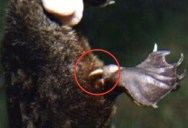Platypus Venom Is Worse Than Childbirth Says Woman Who Tried To Help A Wounded Animal

There are a lot of strange animals and insects on this planet of ours, but for my money, the platypus and its classification-defying specifics has got to be up there.
To wit: they can offload venom through a “stinger” on their back legs.
Good samaritan Jenny Forward found this out the hard way after attempting to assist an injured platypus on the side of the road.
She spotted the platypus in the ditch outside of Kingston, a city in Tasmania. When she attempted to pick up the animal so she could get it some help, the ungrateful and weird creature stung her in the hand.

She told Australian television show Sunrise that the pain was “worse than childbirth,” and that she thought her head “was gonna explode.”
“I picked up this cute little wriggly platypus, next thing you know it twisted round and impaled both its spurs on either side of my right hand. I couldn’t actually get the platypus off my hand because it was stuck on there. It was as though someone had stabbed my hand with a knife. The pain was excruciating…definitely worse than childbirth.”
The platypus is native to eastern Australia, and when explorers initially sent back pelts and drawings, European scientists thought it was some kind of hoax.
It makes sense, since the platypus is one of just five species of mammals that lay eggs – the other four are all echidnas.
It’s semi-aquatic, has a bill like a duck, a tail like a beaver, and feet like an otter.
I mean come on. Who would believe that upon first hearing the description?
All of these monotremes (egg-laying mammals) use electrolocation to navigate murky waters and also to hunt prey – typically worms, insect larvae, and freshwater shrimp.
Platypus are also one of only a handful of mammals that can dispense venom. Only the males of the species have venom, though both sexes have the spurs, and the venom is potent enough to kill anything the size of a dog – their typical predators.

Though humans won’t die, the pain is intense and can linger for up to a week.
In 1992, a 57-year-old war veteran described the pain of the venom as “much worse” than being hit by shrapnel. He was discharged after 6 days, when the pain became “tolerable,” and still reported pain 2 weeks after the injury.
As far as Ms. Forward, she’s not holding the encounter against the platypus, and intends to continue helping wildlife.
“I’m definitely going to look at what the Kingborough Council is doing to protect them and maybe set up a small group to make sure our waterways are free of this awful litter that’s killing them.”
Like many species around the world, the platypus is vulnerable to extinction thanks to human impact on its habitat.
Thought that was fascinating? Here’s another story you might like: Why You’ll Never See A Great White Shark In An Aquarium

Sign up to get our BEST stories of the week straight to your inbox.




